When Maria Montessori developed her educational method, she created programs that encompass a three-year learning cycle. This three-year cycle corresponds with Montessori’s planes of development, each of which spans six years of the child’s life:
- First plane: 0–6 years (Absorbent Mind)
- Second plane: 6–12 years (Childhood)
- Third plane: 12–18 years (Adolescence)
- Fourth plane: 18–24 years (Young Adult)
Within each plane of development, there is a natural separation and transformation that occurs every three years. Humans require different environments to support different developmental needs that they are seeking to be met through each of the Planes of Development.
In the 3-6 environment, different developmental characteristics are supported in each of the 3 years that the child is in their Children’s House.
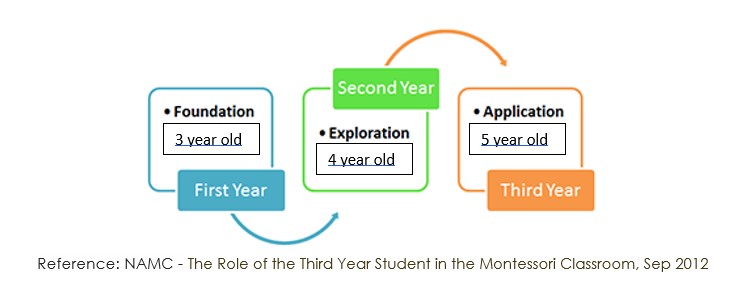
The 3 year old often observes the work of others throughout the day, learning socially through the observation of their community and interactions with the adult with lessons in Practical Life, the sensorial area and Grace and Courtesy. Their oral language is developed and extended as it is the basis of later literacy success.
This lays the foundation for more exploration of the curriculum as a 4 year old. As they are now able to concentrate on longer sequences of work they are given lessons in the mathematics area and they begin to use the language materials. They are extended with more complex sensorial impressions and delve into the cultural area such as the Maps.
The 5 year old is capable of many things and is now able to apply the knowledge that they have gained in their previous 2 years with independence and confidence. It is a year that many intrinsic characteristics are developed. There is a lot of talk about the characteristics that our children will need for future success and these are inherent within the framework of the 3 year cycle. Whilst accelerated academics are a great benefit of the third year of the Montessori preschool cycle, realise that your child is acquiring potentially far more powerful assets, such as leadership, problem solving, higher order thinking skills, executive functioning, kindness and empathy, connection to reality and others, collaboration and perseverance.
The 3-year cycle also allows your child to acquire skills and academic knowledge at their own pace. Perhaps reading comes more quickly than math, or fine-motor skills seemed second nature while gross-motor skills took longer. The Montessori Early Childhood environment has no set timetable for mastery but instead offers the child 3 full years to acquire the capability.
Please enjoy a snapshot of some of the work that the 5 year olds are capable of achieving at FMS throughout their third year in a 3-6 environment.
Practical Life
Practical Life connects the child to their community and aids their growing need for independence. In the first 2 years it is about achieving independent skills surrounding care of self and their environment.
In the final year, the 5 year old child is finally able to use those skills in a social context as they help others who are still developing these skills. Small tasks such as tying a bow for someone’s shoe or apron, helping to sweep up a mess on the floor, helping a friend push down the apple cutter, roll a small mat, find an object or sharpen a pencil.
Whilst these tasks seem small to the adult, in the 5 year old child they are extremely important as they build a great sense of self and develop a habit of helping others. Children of this age are often on the receiving end of help and may not realise their potential to help others if not given the opportunity to assume that role in their third year. Children become what they do and the practical life curriculum is another culminating area that is so important for the development of those intrinsic characteristics of the child’s personality.
Language
Montessori places strong emphasis on phonetic awareness and the materials are designed to educate children on spoken and written language. Making a connection and gaining a relationship with phonetic sounds helps children to practice and articulate the sounds in speech and explore how combined sounds form words. This is done by practicing Sandpaper Letters, Small and Large Movable Alphabets, Phonogram Sounds, writing, reading comprehension and with receptive and expressive language.
After 2 years of developing the child’s oral language, phonological and phonemic awareness and preparing their hand for writing in many ways, the 5 year old child is capable of great self-expression and creativity as they move through more complex explorations of the exercises of reading and writing.




Science
Montessori education introduces children to complex topics in the early years, preparing the children for a life time of discovery and learning. Through various experiments the children are given the opportunity to learn about their universe and how precious and wonderous life is on Earth.




Cultural Area
The Cultural program connects the individual to the world.
The Montessori program has the flexibility to introduce a broad range of cultural concepts. These concepts are integrated into the child’s daily education and are built upon in sequence adding layers to their understanding.
The Cultural materials provide the roots for Geography – Puzzle Maps (Names- Cities) Geography folders (Each section has People, Places, Food and Costumes)
The children have access to the Music bells. They are able to compose tunes, notation and music classifications.
The older child likes to ask Why, Where and What questions and are often not satisfied with short answers, they need to do research and look up answers. We call upon our 6-12 students for help and advice. We provide tools in the classroom for the children so they gain access to knowledge.
In Montessori classrooms, we have always worked with real objects and the correct names, the children have learnt about real life situations in the Geography folders, seen Atlases, Flags of real countries. They have worked with Land and Water forms depicting real Land forms.
We work on days of the week, months and seasons of the year, 5 year olds are interested in birthdays and sequences of family birthdays. We follow the interest of the children and work with an individual or we work as a group. We believe the child needs to be grounded in the real world.
Maria Montessori looks at the development of the child as an individual and the individual as part of a local community and then the global community and builds a love for their world and the people, fauna and flora who inhabit it.
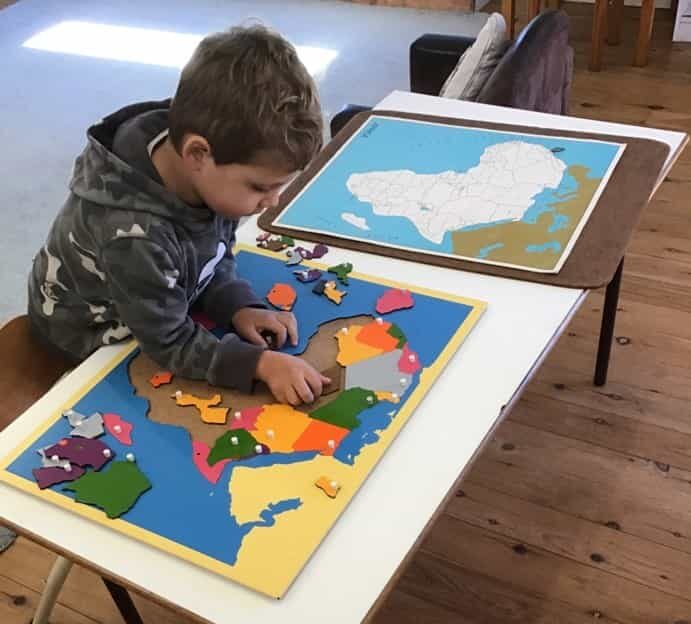
Mathematics
Here a child works with linear counting up to 1000 and indirectly works with the cube of 10.
In the 3-6 environment we classify mathematics into groups. It’s about ideas and concepts, Montessori’s principal is about giving the child only one difficulty at a time. Within each group, we follow the same pattern, we are always trying to give the child the vision of the whole concept and then we break it up into parts. Any new concept is introduced in a really concrete way, the child works with the quantity and then we offer the more abstract representation of that concept – the written numeral. Then we give them experiences with combining the numeral with the quantity.
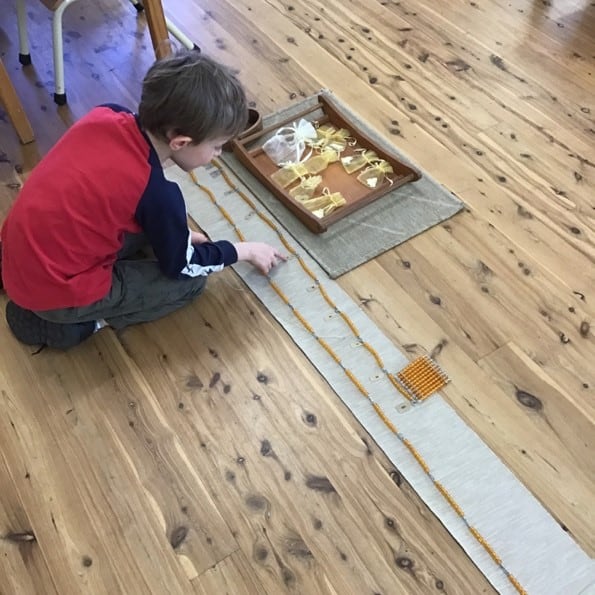
Sensorial
The 5 year old starts to see connections between the sensorial materials that they have worked with during their previous 2 years. This develops deep knowledge as they are able to discover and explore relationships between the materials in new ways and apply their well-developed visual discrimination to extend their knowledge further.
These connections are child led and are not part of the lessons that we give them. In the third year they naturally discover these creative connections within the truly integrated curriculum that Montessori provides for the 3-6 child and beyond.
Sport
The 5 year old’s need for more complex movement is supported with the introduction of sport taught by a specialist. This not only develops their fundamental movement skills but also connects them with the 9-12 children as role models and friends in a collaborative and fun atmosphere.
Developing a love for physical activity and learning to work as a team in a non-competitive environment. The 5 year old children are also assisted by the children in 9-12 to continue to provide them with a mixed age environment and access to all the benefits it achieves.
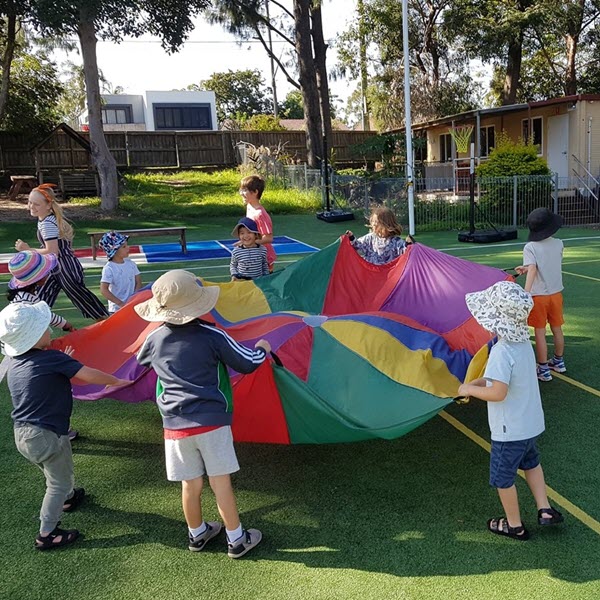
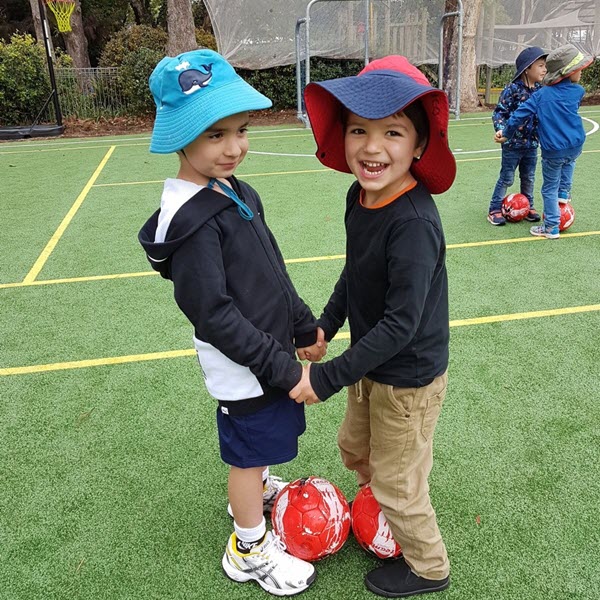
Gaining confidence in sports specific skills whilst building on fundamental movement skills through fun game-based activities and individual challenges.
We hope that this has given you a glimpse of what the 5 year old can achieve within their final year in 3 – 6 and whilst the vast curriculum extends beyond traditional Kindergarten expectations, we hope that we have also shown how the intrinsic qualities of character are also developed in this final year in 3-6
If you have any questions about the importance of the third year (the Kindergarten year) for your child in the 3-6 program or how the Montessori curriculum flows into the 6-12 years then please speak to us further. We would be happy to discuss it with you.
With gratitude,
The 3-6 Staff Team



